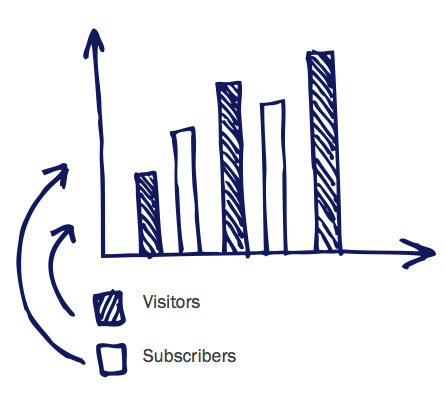This is an excerpt from HubSpot's ebook, "An Introduction to Business Blogging."Download the complete ebook for more marketing tips about business blogging.
Business blogging without measuring results is a complete waste of time. But when it comes to your business blog, there are a whole range of metrics you can consider. In fact, the number of blogging metrics can get so overwhelming that tracking them all wouldn’t leave much time for blogging, let alone other important aspects of inbound marketing.
Let’s look at the most important metrics you need to keep an eye on to know how your business blogging is going.
1. Measure Visitors
One of the most basic metrics is also one of the most important ones. Visits are the count of people who actually read your blog content. It’s interesting to look at your total number of visits to measure the overall improvement of your blog. However, a better way to look at this data is viewing visits by individual blog articles. Looking at success factors for individual articles helps you better understand the type of content your target audience is looking for. Look at your five most successful blog posts. What do they have in common?
2. Measure Leads
If your business blog isn’t generating leads for your business, you are missing a huge opportunity. Leads are what fuels the growth and success of your business, and they are also the true measure of a successful business blog. Sometimes a post may not get a ton of visits but still generate lots of leads. Without looking at the leads metric, a marketer might easily dismiss the less viewed post as a failure when that shouldn’t necessarily be the case. Look at the leads you generate from blog posts. Also examine at what rate those leads convert into customers compared to other marketing channels.
3. Measure Subscribers
It takes more than reading one blog article for a person to develop an understanding of your expertise and credibility within your industry. Giving readers the opportunity to subscribe to your blog either via Really Simple Syndication (RSS) or via email is a common characteristic of a well-planned blog. Looking at how many people subscribe to your blog provides a solid indicator of the quality and consistency of your content. Your subscribers act as the base readership of your content and can help spread it to others.
4. Track Inbound Links
When another website links to a page on your website, we call this an inbound link. Search engines use inbound links as a method to determine how pages appear and rank in search engine results. As blog posts are normally educational rather than product-centric, they are great at generating inbound links and, subsequently, search traffic. It is important to look at how many inbound links each of your blog posts attracts. Different types of blog posts and topics will vary in the number of inbound links they drive. Looking at these metrics for each post will enable you to maintain a well-balanced content strategy for your blog.
5. Watch Social Media Shares
Social media can be a key driver of short-term traffic. Look at the historic social media shares for your blog posts to determine which types get the most short-term traffic from social media. Compare that data to the number of visits or leads to see if there are any major inconsistencies. What could they be due to, and how can you use them to your advantage?
Measure the performance of your business blog regularly to identify weaknesses in the content you're producing, what topics your audience truly cares about, and what blogging tactics work for you. Then modify your blogging strategy to do more of what works and less of what doesn't to make all the time and effort you're putting into your business blog truly worth it.
Want to learn more about business blogging? Grab HubSpot's free ebook, "An Introduction to Business Blogging."

Blog Optimization
.png?width=112&height=112&name=Image%20Hackathon%20%E2%80%93%20Horizontal%20(67).png)









![5 Ideas for Creating Killer Evergreen Content [+ Examples]](https://53.fs1.hubspotusercontent-na1.net/hubfs/53/Evergreen-content.jpg)
